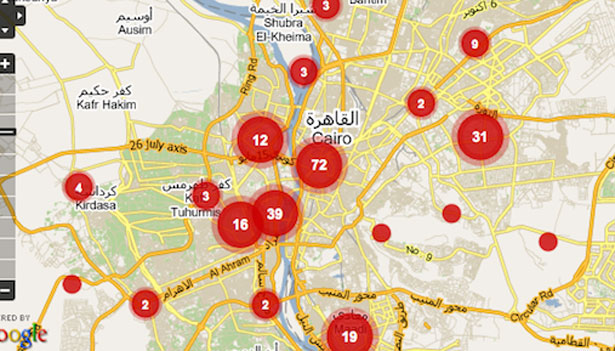
HarassMap report. (Courtesy of HarassMap)
This is part six in my series on the global epidemic of violence against women. (Here are my posts on Serena Williams’s victim-blaming, the sexual assaults happening in Egypt, the forced sterilization of incarcerated women in California, rape and social media, and George Zimmerman’s prior acts of violence against women.)
The advent of smart phones and social media has not only ushered in new methods of shaming rape victims but also generated applications, some of them free, used to prevent sexual violence itself.
This is how they work: GPS-enabled phones send data to Circle of 6, OnWatch, Bsafe and other app makers to show your location. Some apps also allow users to receive an emergency phone call from their contacts, call 911, or track them as they walk to their destination).
Many of these apps were submitted in the White House’s 2011 “Apps Against Abuse” technology challenge—a national competition to provide young adults with tools to help prevent sexual assault and dating violence.
Circle of 6 was one of the two winners. “In the fight against gender-based violence, mobile and mapping technology provide concrete tools to connect people to each other and to critical resources,” said Nancy Schwartzman, co-creator of the Circle of 6, an app that is both free and simple to use.
On Circle of 6, you upload six of your most reliable contacts (your trusted circle) to which you can send the following texts: “I’m looking up healthy relationship info,” “call me I need an interruption” and “come and get me” and your location will be immediately sent to them.
I did send the “call me” text to my circle at lunchtime, and the only responses I received were “I am in meeting right now” and two phone calls fifteen minutes to an hour later. My friends seemed to be thrown off by the Circle of 6 verbiage that preceded my “come and get me” alert (at least that’s what they said).
Popular
"swipe left below to view more authors"Swipe →
Schwartzman texted me that to avoid such responses, "We usually encourage folks to talk to their friends about the app and putting them in their circle, so it is not a surprise when it happens. It can be of course, but the app is also trying to encourage conversations." I’m definitely rethinking my circle now, not the app. Of all the ones I tested, Circle of 6 was by far my favorite.
The other winner was OnWatch, which customizes alert modes to allow users to contact their friends, your Campus Police, local 911, or all three if they need help via phone, text, e-mail and Facebook. Two exciting features about this app are: the Watch My Back timer countdown and “I’m Here” alert. Since I opted out of the monthly subscription of $4.99 or yearly-one for $49.99, I could only use them during my a one-month free-trial period.
Similarly, B-Safe, the personal safety alarm has a monthly subscription of $1.99 and annual subscription of $19.99. Endorsed by celebrity Jada Pinkett-Smith, B-Safe is has a red alarm button that will automatically alert your “guardians” of a threat and text them a map with your location for help. My favorite was the Fake Call function, which allowed you to select the caller and the time of the call ranging from immediately to ten seconds to ten minutes. Before this app, I would just pick up the phone and have imaginary conversations in order to stave off the jeers from street harassers.
But while all of these apps are geared towards people that are active texters and high school or college aged users, there is rise of sexual assault mapping by organizations, like HarrassMap and Women Under Siege, that use crowd-sourcing to help people who are locally organizing to end sexual violence or traveling internationally. These maps record every instance of sexual assault and harassment submitted to their site.
In the recent protest in Egypt, HarrassMap has been particularly effective in helping victims of sexual violence. “HarassMap takes a social approach,” said Rebecca Chiao, co-founder of HarrasMap in Egypt. “We do direct interventions to rescue the women, but in our normal, long-term work, we target bystanders to intervene.”
Unfortunately, since 80 precent of sexual assaults are committed by an acquaintance rather than a stranger, users are likely to constrained by the same factors—fear, shame, and guilt—that typically inhibit victims from getting help. And because none of the apps can prevent perpetrators from targeting victims, there is a risk that that potential victims are made to feel responsible for sexual assault prevention.
But, they also do something more. They innovatively engage and redefine the bystander as friends, guardians, survivors of gender-based violence, volunteers and witnesses, in order to reduce the likelihood of individual and collective acts of sexual violence.
As a survivor of sexual violence, it is good to know there is an app for that.
This is part six in my series on the global epidemic of violence against women. (Here are my posts on Serena Williams’s victim-blaming, the sexual assaults happening in Egypt, the forced sterilization of incarcerated women in California, rape and social media, and George Zimmerman’s prior acts of violence against women.)
Editor's Note: This post has been updated with a response from Nancy Schwartzmann.


